Nursing Communication Program: Developing a Course Evaluation Template
VerifiedAdded on 2023/06/10
|9
|1611
|90
Report
AI Summary
This assignment focuses on developing a standardized template for evaluating a nursing communication course. It includes an assessment template with questions to evaluate the teacher, the learning process (attainment of learning objectives and outcomes), and the learning environment. The executive summary provides a rationale for the chosen assessment methods, emphasizing their validity and reliability. It also highlights the importance of assessing the cognitive, psychomotor, and affective domains of learning. The template aims to identify strengths and weaknesses in teaching and the learning environment to improve the overall effectiveness of the nursing communication course. The evaluation uses learner feedback to assess the teacher's subject knowledge, teaching methodologies, and communication skills. The assessment helps determine whether the learning objectives and program outcomes are being met and whether the learning environment facilitates effective learning. The conclusion emphasizes the importance of assessing learning to ensure its effectiveness and alignment with course objectives.
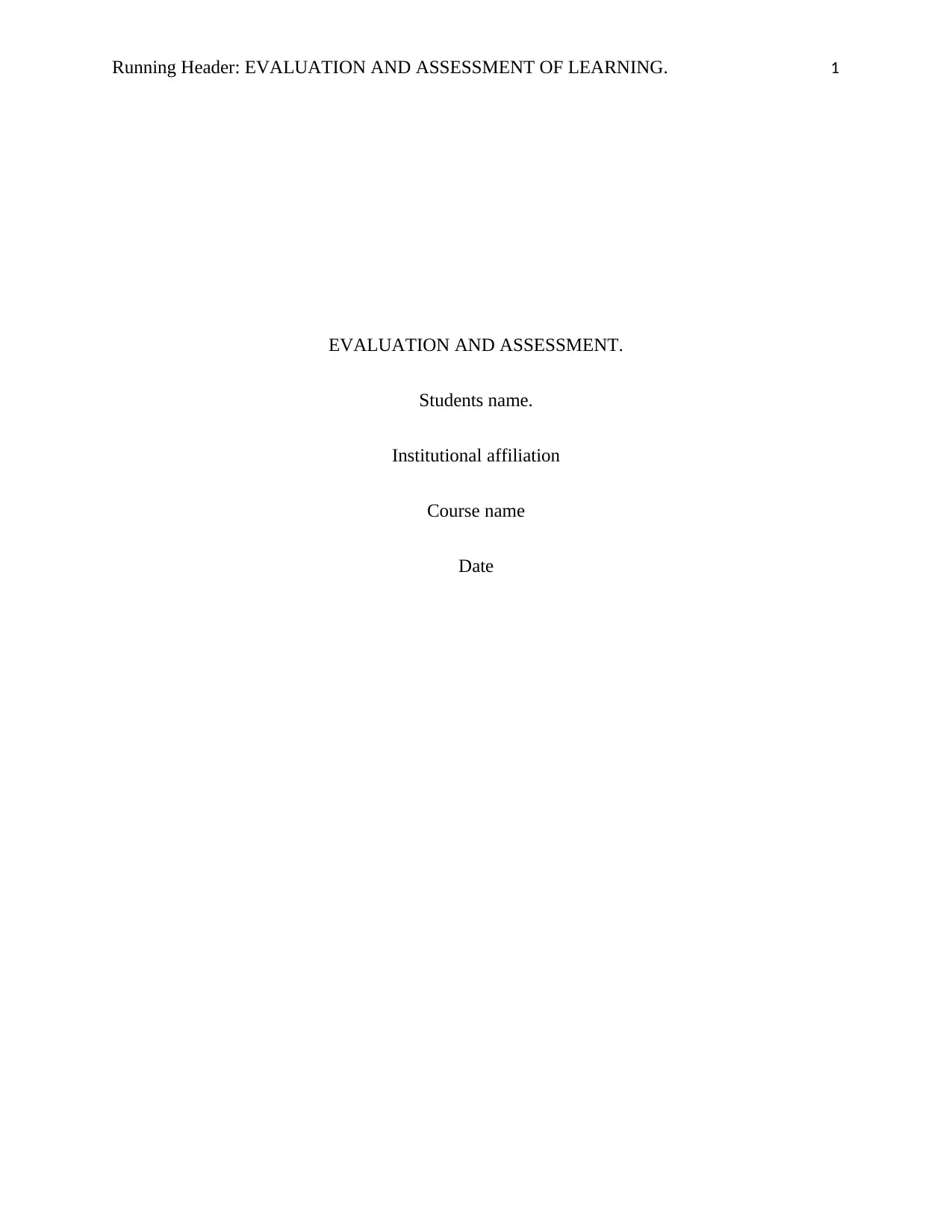
Running Header: EVALUATION AND ASSESSMENT OF LEARNING. 1
EVALUATION AND ASSESSMENT.
Students name.
Institutional affiliation
Course name
Date
EVALUATION AND ASSESSMENT.
Students name.
Institutional affiliation
Course name
Date
Paraphrase This Document
Need a fresh take? Get an instant paraphrase of this document with our AI Paraphraser
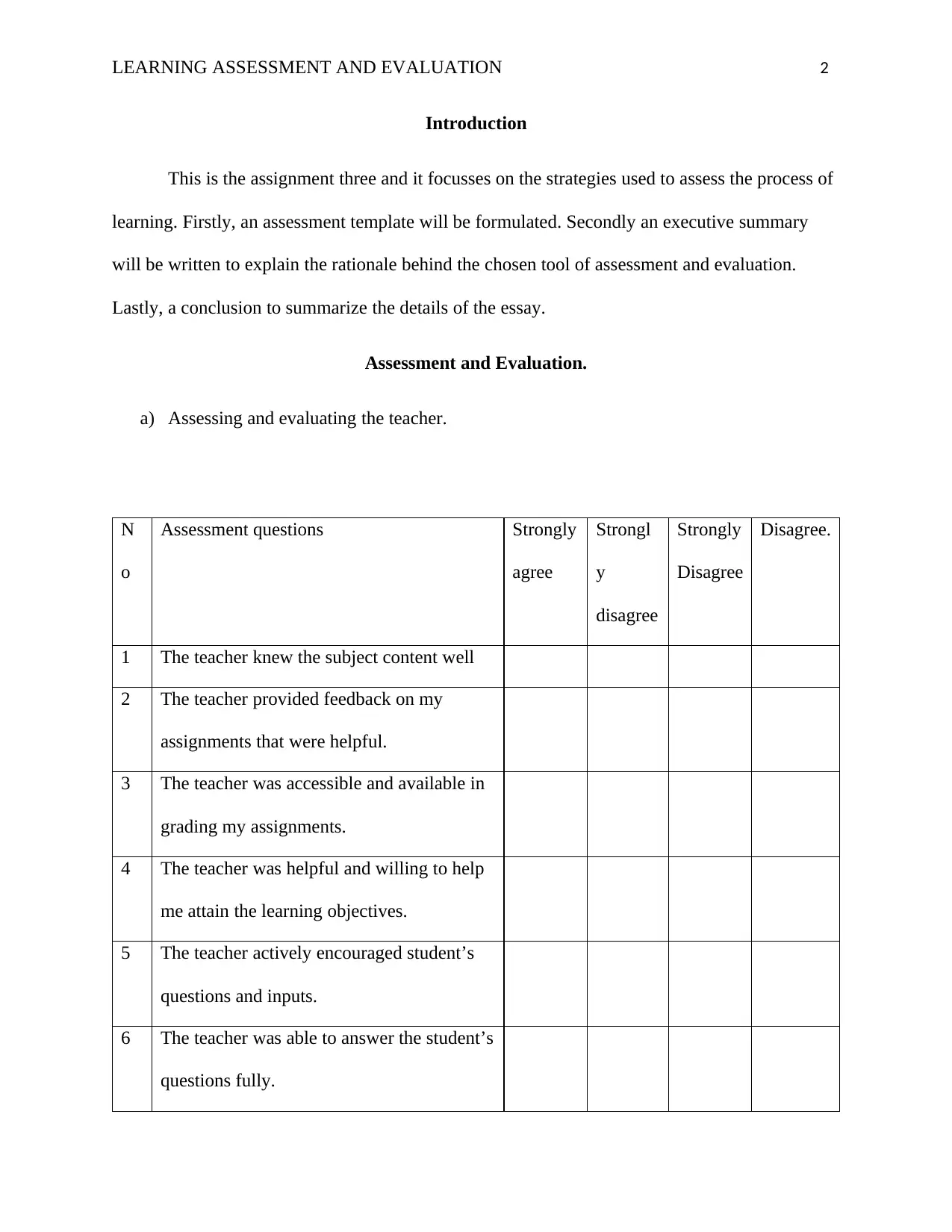
LEARNING ASSESSMENT AND EVALUATION 2
Introduction
This is the assignment three and it focusses on the strategies used to assess the process of
learning. Firstly, an assessment template will be formulated. Secondly an executive summary
will be written to explain the rationale behind the chosen tool of assessment and evaluation.
Lastly, a conclusion to summarize the details of the essay.
Assessment and Evaluation.
a) Assessing and evaluating the teacher.
N
o
Assessment questions Strongly
agree
Strongl
y
disagree
Strongly
Disagree
Disagree.
1 The teacher knew the subject content well
2 The teacher provided feedback on my
assignments that were helpful.
3 The teacher was accessible and available in
grading my assignments.
4 The teacher was helpful and willing to help
me attain the learning objectives.
5 The teacher actively encouraged student’s
questions and inputs.
6 The teacher was able to answer the student’s
questions fully.
Introduction
This is the assignment three and it focusses on the strategies used to assess the process of
learning. Firstly, an assessment template will be formulated. Secondly an executive summary
will be written to explain the rationale behind the chosen tool of assessment and evaluation.
Lastly, a conclusion to summarize the details of the essay.
Assessment and Evaluation.
a) Assessing and evaluating the teacher.
N
o
Assessment questions Strongly
agree
Strongl
y
disagree
Strongly
Disagree
Disagree.
1 The teacher knew the subject content well
2 The teacher provided feedback on my
assignments that were helpful.
3 The teacher was accessible and available in
grading my assignments.
4 The teacher was helpful and willing to help
me attain the learning objectives.
5 The teacher actively encouraged student’s
questions and inputs.
6 The teacher was able to answer the student’s
questions fully.

LEARNING ASSESSMENT AND EVALUATION 3
7 The teacher used teaching aids to enhance
learning.
8 I would take another course from this
teacher.
9 The teachers’, teaching styles were
appropriate.
10 The teacher was able to relate the course
content and my line of career.
b) Assessing and evaluating the learning process (attainment of the learning objectives and
learning outcomes, both in the classroom and the clinical area).
N
o
Assessment questions Strongly
agree
Strongl
y
disagree
Strongly
Disagree
Disagree.
1 Learning objectives taught were
understandable and clear.
2 The learning experiences I gained helped me
in achieving the learning results.
3 The learning experiences I was exposed to,
were appropriate, well organized, and
designed.
7 The teacher used teaching aids to enhance
learning.
8 I would take another course from this
teacher.
9 The teachers’, teaching styles were
appropriate.
10 The teacher was able to relate the course
content and my line of career.
b) Assessing and evaluating the learning process (attainment of the learning objectives and
learning outcomes, both in the classroom and the clinical area).
N
o
Assessment questions Strongly
agree
Strongl
y
disagree
Strongly
Disagree
Disagree.
1 Learning objectives taught were
understandable and clear.
2 The learning experiences I gained helped me
in achieving the learning results.
3 The learning experiences I was exposed to,
were appropriate, well organized, and
designed.
⊘ This is a preview!⊘
Do you want full access?
Subscribe today to unlock all pages.

Trusted by 1+ million students worldwide
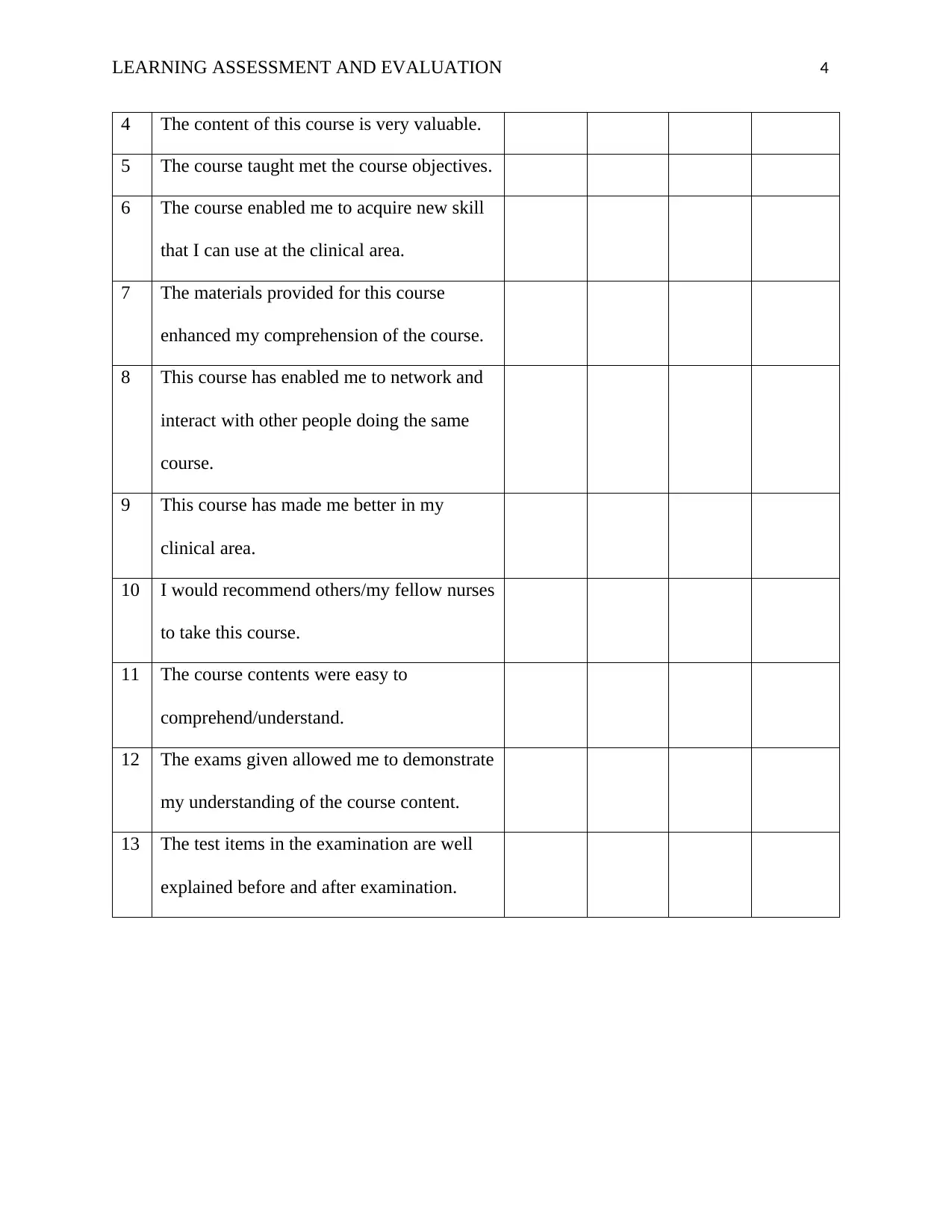
LEARNING ASSESSMENT AND EVALUATION 4
4 The content of this course is very valuable.
5 The course taught met the course objectives.
6 The course enabled me to acquire new skill
that I can use at the clinical area.
7 The materials provided for this course
enhanced my comprehension of the course.
8 This course has enabled me to network and
interact with other people doing the same
course.
9 This course has made me better in my
clinical area.
10 I would recommend others/my fellow nurses
to take this course.
11 The course contents were easy to
comprehend/understand.
12 The exams given allowed me to demonstrate
my understanding of the course content.
13 The test items in the examination are well
explained before and after examination.
4 The content of this course is very valuable.
5 The course taught met the course objectives.
6 The course enabled me to acquire new skill
that I can use at the clinical area.
7 The materials provided for this course
enhanced my comprehension of the course.
8 This course has enabled me to network and
interact with other people doing the same
course.
9 This course has made me better in my
clinical area.
10 I would recommend others/my fellow nurses
to take this course.
11 The course contents were easy to
comprehend/understand.
12 The exams given allowed me to demonstrate
my understanding of the course content.
13 The test items in the examination are well
explained before and after examination.
Paraphrase This Document
Need a fresh take? Get an instant paraphrase of this document with our AI Paraphraser
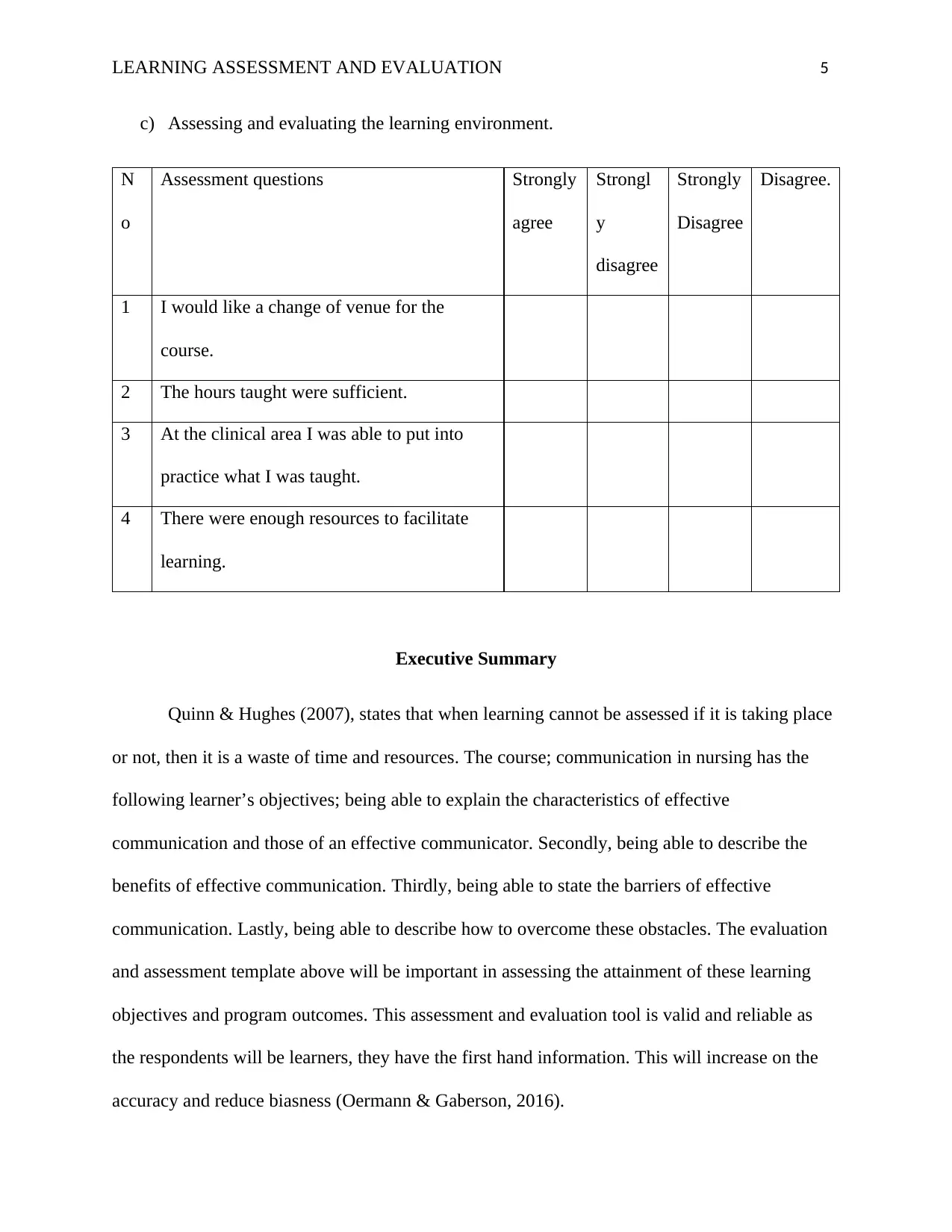
LEARNING ASSESSMENT AND EVALUATION 5
c) Assessing and evaluating the learning environment.
N
o
Assessment questions Strongly
agree
Strongl
y
disagree
Strongly
Disagree
Disagree.
1 I would like a change of venue for the
course.
2 The hours taught were sufficient.
3 At the clinical area I was able to put into
practice what I was taught.
4 There were enough resources to facilitate
learning.
Executive Summary
Quinn & Hughes (2007), states that when learning cannot be assessed if it is taking place
or not, then it is a waste of time and resources. The course; communication in nursing has the
following learner’s objectives; being able to explain the characteristics of effective
communication and those of an effective communicator. Secondly, being able to describe the
benefits of effective communication. Thirdly, being able to state the barriers of effective
communication. Lastly, being able to describe how to overcome these obstacles. The evaluation
and assessment template above will be important in assessing the attainment of these learning
objectives and program outcomes. This assessment and evaluation tool is valid and reliable as
the respondents will be learners, they have the first hand information. This will increase on the
accuracy and reduce biasness (Oermann & Gaberson, 2016).
c) Assessing and evaluating the learning environment.
N
o
Assessment questions Strongly
agree
Strongl
y
disagree
Strongly
Disagree
Disagree.
1 I would like a change of venue for the
course.
2 The hours taught were sufficient.
3 At the clinical area I was able to put into
practice what I was taught.
4 There were enough resources to facilitate
learning.
Executive Summary
Quinn & Hughes (2007), states that when learning cannot be assessed if it is taking place
or not, then it is a waste of time and resources. The course; communication in nursing has the
following learner’s objectives; being able to explain the characteristics of effective
communication and those of an effective communicator. Secondly, being able to describe the
benefits of effective communication. Thirdly, being able to state the barriers of effective
communication. Lastly, being able to describe how to overcome these obstacles. The evaluation
and assessment template above will be important in assessing the attainment of these learning
objectives and program outcomes. This assessment and evaluation tool is valid and reliable as
the respondents will be learners, they have the first hand information. This will increase on the
accuracy and reduce biasness (Oermann & Gaberson, 2016).

LEARNING ASSESSMENT AND EVALUATION 6
The instructor is assessed and evaluated using the assessment template. This is obtained
from responses of the following questions; the subject contents of the teacher, the teaching
methodology/styles used by the teacher, the teacher’s confidence, communication skills and the
interaction. This is important as the above factors influence attainments of the specified learning
objectives being met. When the teacher has content on the subject matter, uses the right teaching
methodologies and be confident and effective communicators, there is no doubt that the course
outcomes and objectives will be met. This evaluation is important as it will help in identifying
the strengths and weakness areas of the teacher. The teacher will use this so as to improve on the
delivery (Oermann & Gaberson, 2016; Anderson, Krathwohl, Airasian, Cruikshank, Mayer,
Pintrich ... 2016).
In addition to this, the three domains of the learning are being assessed by the template
above. The cognitive domain is the knowledge useful in thinking, comprehending, synthesizing,
analyzing, applying and evaluating. This has been assessed through the following questions from
the template; (the course contents were easy to comprehend and the exams given allowed one to
be able to demonstrate their understanding). The second domain, the psychomotor, tests the skills
attained from the course. The template assesses this through attainment of new skills by the
student and by their expression that the course has made it easier to work or has improved their
efficiency. Lastly, the affect domain which tests the learner’s attitude, interests and experiences
of the course/program. This will be assessed when asked if they can recommend this course to
others and if the course is valuable. It is important to assess these three domains as they are the
basis in which objectives are formulated and their attainment translates to objectives being met
(Fastré, van der Klink, Amsing-Smit, & van Merriënboer, 2014).
The instructor is assessed and evaluated using the assessment template. This is obtained
from responses of the following questions; the subject contents of the teacher, the teaching
methodology/styles used by the teacher, the teacher’s confidence, communication skills and the
interaction. This is important as the above factors influence attainments of the specified learning
objectives being met. When the teacher has content on the subject matter, uses the right teaching
methodologies and be confident and effective communicators, there is no doubt that the course
outcomes and objectives will be met. This evaluation is important as it will help in identifying
the strengths and weakness areas of the teacher. The teacher will use this so as to improve on the
delivery (Oermann & Gaberson, 2016; Anderson, Krathwohl, Airasian, Cruikshank, Mayer,
Pintrich ... 2016).
In addition to this, the three domains of the learning are being assessed by the template
above. The cognitive domain is the knowledge useful in thinking, comprehending, synthesizing,
analyzing, applying and evaluating. This has been assessed through the following questions from
the template; (the course contents were easy to comprehend and the exams given allowed one to
be able to demonstrate their understanding). The second domain, the psychomotor, tests the skills
attained from the course. The template assesses this through attainment of new skills by the
student and by their expression that the course has made it easier to work or has improved their
efficiency. Lastly, the affect domain which tests the learner’s attitude, interests and experiences
of the course/program. This will be assessed when asked if they can recommend this course to
others and if the course is valuable. It is important to assess these three domains as they are the
basis in which objectives are formulated and their attainment translates to objectives being met
(Fastré, van der Klink, Amsing-Smit, & van Merriënboer, 2014).
⊘ This is a preview!⊘
Do you want full access?
Subscribe today to unlock all pages.

Trusted by 1+ million students worldwide
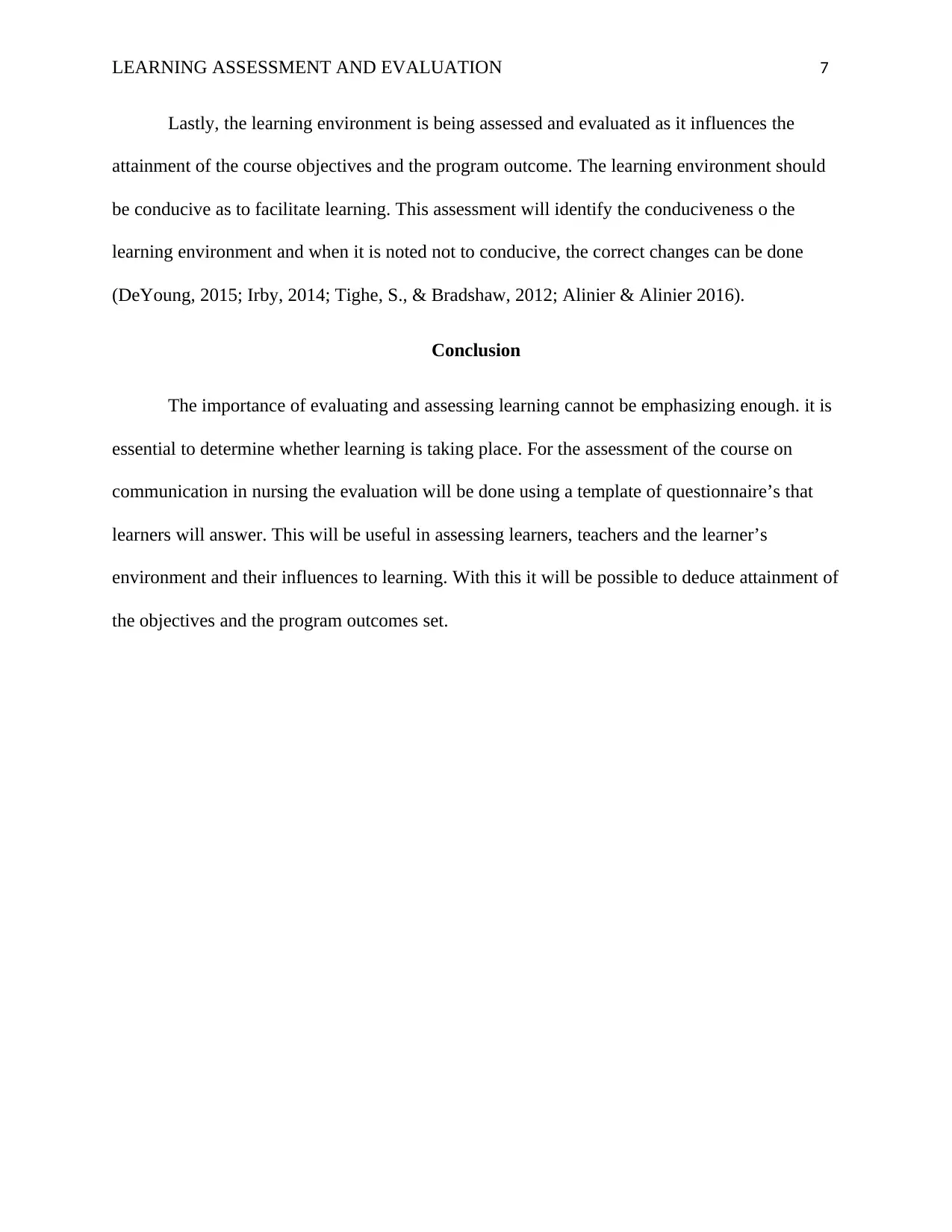
LEARNING ASSESSMENT AND EVALUATION 7
Lastly, the learning environment is being assessed and evaluated as it influences the
attainment of the course objectives and the program outcome. The learning environment should
be conducive as to facilitate learning. This assessment will identify the conduciveness o the
learning environment and when it is noted not to conducive, the correct changes can be done
(DeYoung, 2015; Irby, 2014; Tighe, S., & Bradshaw, 2012; Alinier & Alinier 2016).
Conclusion
The importance of evaluating and assessing learning cannot be emphasizing enough. it is
essential to determine whether learning is taking place. For the assessment of the course on
communication in nursing the evaluation will be done using a template of questionnaire’s that
learners will answer. This will be useful in assessing learners, teachers and the learner’s
environment and their influences to learning. With this it will be possible to deduce attainment of
the objectives and the program outcomes set.
Lastly, the learning environment is being assessed and evaluated as it influences the
attainment of the course objectives and the program outcome. The learning environment should
be conducive as to facilitate learning. This assessment will identify the conduciveness o the
learning environment and when it is noted not to conducive, the correct changes can be done
(DeYoung, 2015; Irby, 2014; Tighe, S., & Bradshaw, 2012; Alinier & Alinier 2016).
Conclusion
The importance of evaluating and assessing learning cannot be emphasizing enough. it is
essential to determine whether learning is taking place. For the assessment of the course on
communication in nursing the evaluation will be done using a template of questionnaire’s that
learners will answer. This will be useful in assessing learners, teachers and the learner’s
environment and their influences to learning. With this it will be possible to deduce attainment of
the objectives and the program outcomes set.
Paraphrase This Document
Need a fresh take? Get an instant paraphrase of this document with our AI Paraphraser
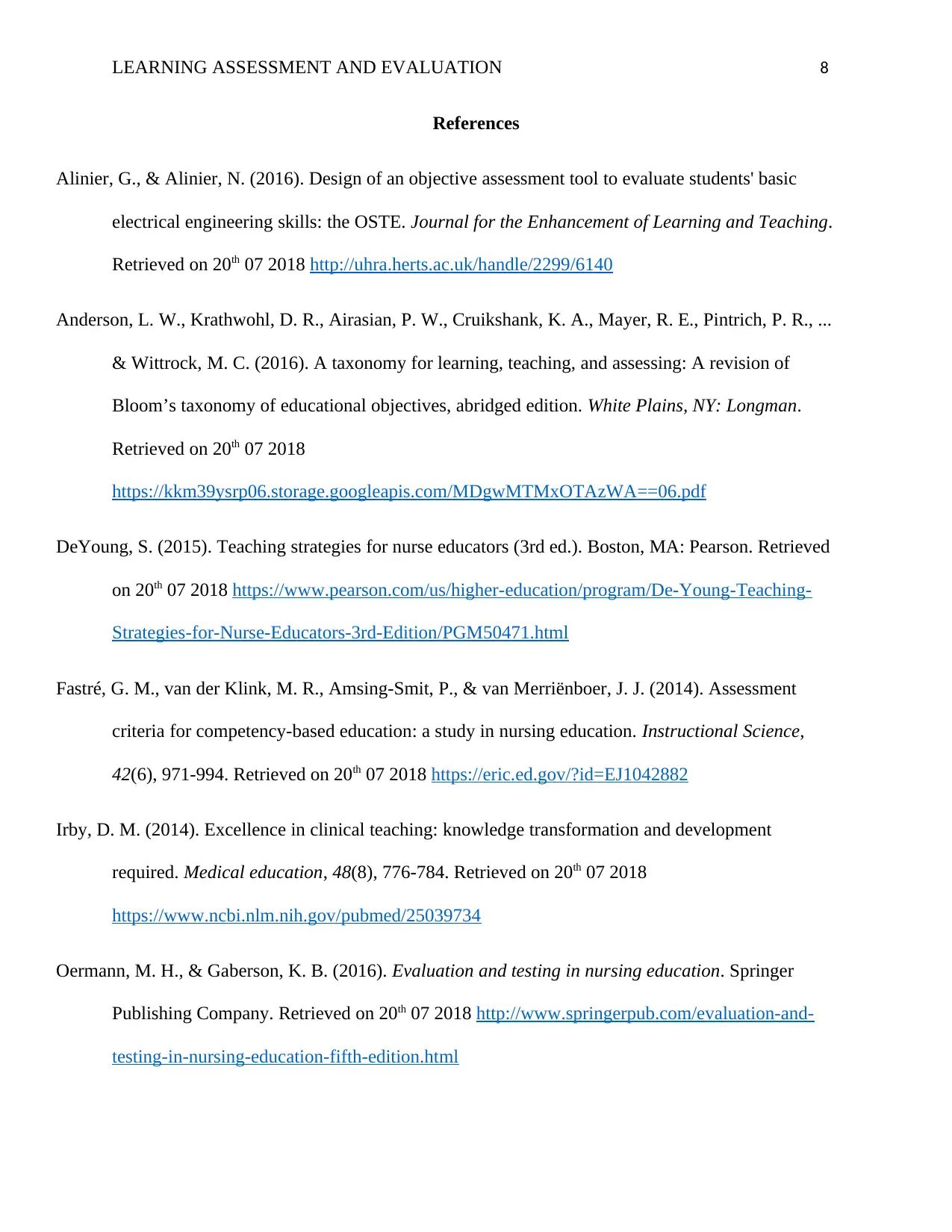
LEARNING ASSESSMENT AND EVALUATION 8
References
Alinier, G., & Alinier, N. (2016). Design of an objective assessment tool to evaluate students' basic
electrical engineering skills: the OSTE. Journal for the Enhancement of Learning and Teaching.
Retrieved on 20th 07 2018 http://uhra.herts.ac.uk/handle/2299/6140
Anderson, L. W., Krathwohl, D. R., Airasian, P. W., Cruikshank, K. A., Mayer, R. E., Pintrich, P. R., ...
& Wittrock, M. C. (2016). A taxonomy for learning, teaching, and assessing: A revision of
Bloom’s taxonomy of educational objectives, abridged edition. White Plains, NY: Longman.
Retrieved on 20th 07 2018
https://kkm39ysrp06.storage.googleapis.com/MDgwMTMxOTAzWA==06.pdf
DeYoung, S. (2015). Teaching strategies for nurse educators (3rd ed.). Boston, MA: Pearson. Retrieved
on 20th 07 2018 https://www.pearson.com/us/higher-education/program/De-Young-Teaching-
Strategies-for-Nurse-Educators-3rd-Edition/PGM50471.html
Fastré, G. M., van der Klink, M. R., Amsing-Smit, P., & van Merriënboer, J. J. (2014). Assessment
criteria for competency-based education: a study in nursing education. Instructional Science,
42(6), 971-994. Retrieved on 20th 07 2018 https://eric.ed.gov/?id=EJ1042882
Irby, D. M. (2014). Excellence in clinical teaching: knowledge transformation and development
required. Medical education, 48(8), 776-784. Retrieved on 20th 07 2018
https://www.ncbi.nlm.nih.gov/pubmed/25039734
Oermann, M. H., & Gaberson, K. B. (2016). Evaluation and testing in nursing education. Springer
Publishing Company. Retrieved on 20th 07 2018 http://www.springerpub.com/evaluation-and-
testing-in-nursing-education-fifth-edition.html
References
Alinier, G., & Alinier, N. (2016). Design of an objective assessment tool to evaluate students' basic
electrical engineering skills: the OSTE. Journal for the Enhancement of Learning and Teaching.
Retrieved on 20th 07 2018 http://uhra.herts.ac.uk/handle/2299/6140
Anderson, L. W., Krathwohl, D. R., Airasian, P. W., Cruikshank, K. A., Mayer, R. E., Pintrich, P. R., ...
& Wittrock, M. C. (2016). A taxonomy for learning, teaching, and assessing: A revision of
Bloom’s taxonomy of educational objectives, abridged edition. White Plains, NY: Longman.
Retrieved on 20th 07 2018
https://kkm39ysrp06.storage.googleapis.com/MDgwMTMxOTAzWA==06.pdf
DeYoung, S. (2015). Teaching strategies for nurse educators (3rd ed.). Boston, MA: Pearson. Retrieved
on 20th 07 2018 https://www.pearson.com/us/higher-education/program/De-Young-Teaching-
Strategies-for-Nurse-Educators-3rd-Edition/PGM50471.html
Fastré, G. M., van der Klink, M. R., Amsing-Smit, P., & van Merriënboer, J. J. (2014). Assessment
criteria for competency-based education: a study in nursing education. Instructional Science,
42(6), 971-994. Retrieved on 20th 07 2018 https://eric.ed.gov/?id=EJ1042882
Irby, D. M. (2014). Excellence in clinical teaching: knowledge transformation and development
required. Medical education, 48(8), 776-784. Retrieved on 20th 07 2018
https://www.ncbi.nlm.nih.gov/pubmed/25039734
Oermann, M. H., & Gaberson, K. B. (2016). Evaluation and testing in nursing education. Springer
Publishing Company. Retrieved on 20th 07 2018 http://www.springerpub.com/evaluation-and-
testing-in-nursing-education-fifth-edition.html
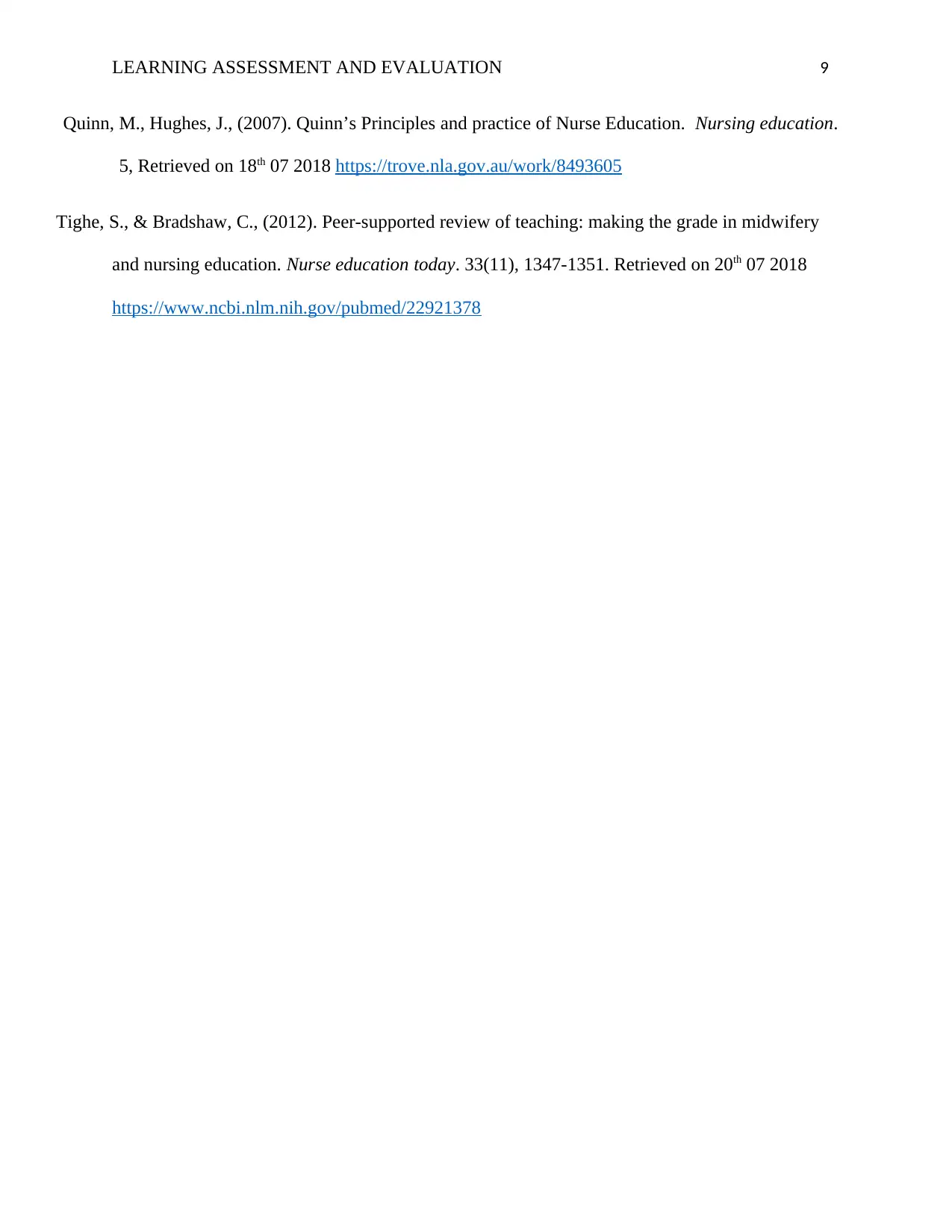
LEARNING ASSESSMENT AND EVALUATION 9
Quinn, M., Hughes, J., (2007). Quinn’s Principles and practice of Nurse Education. Nursing education.
5, Retrieved on 18th 07 2018 https://trove.nla.gov.au/work/8493605
Tighe, S., & Bradshaw, C., (2012). Peer-supported review of teaching: making the grade in midwifery
and nursing education. Nurse education today. 33(11), 1347-1351. Retrieved on 20th 07 2018
https://www.ncbi.nlm.nih.gov/pubmed/22921378
Quinn, M., Hughes, J., (2007). Quinn’s Principles and practice of Nurse Education. Nursing education.
5, Retrieved on 18th 07 2018 https://trove.nla.gov.au/work/8493605
Tighe, S., & Bradshaw, C., (2012). Peer-supported review of teaching: making the grade in midwifery
and nursing education. Nurse education today. 33(11), 1347-1351. Retrieved on 20th 07 2018
https://www.ncbi.nlm.nih.gov/pubmed/22921378
⊘ This is a preview!⊘
Do you want full access?
Subscribe today to unlock all pages.

Trusted by 1+ million students worldwide
1 out of 9
Related Documents
Your All-in-One AI-Powered Toolkit for Academic Success.
+13062052269
info@desklib.com
Available 24*7 on WhatsApp / Email
![[object Object]](/_next/static/media/star-bottom.7253800d.svg)
Unlock your academic potential
Copyright © 2020–2025 A2Z Services. All Rights Reserved. Developed and managed by ZUCOL.





